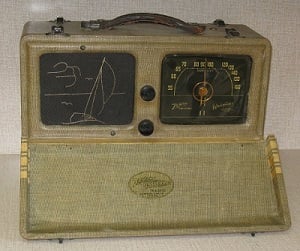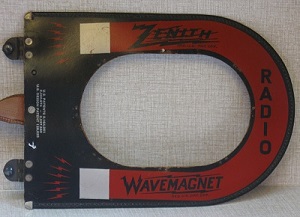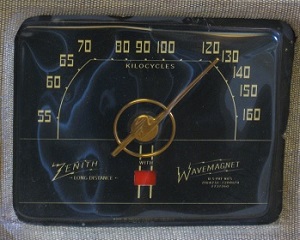Suitcase Radio: Zenith Portable Receiver | Telos Alliance
By The Telos Alliance Team on Oct 28, 2014 3:05:00 PM
 Suitcase Radio: Zenith Portable Receiver
Suitcase Radio: Zenith Portable Receiver
One of the great things about radio is its portability. Take it to the beach, in your boat, on a train. Take it just about anywhere. What's changed over the years is how easy it is to do that. Nowadays we take the portability of radio for granted, as we stuff a smart phone with a built-in FM tuner in our pocket and head out the door. It wasn't always that easy. This month's Found in the Attic examines suitcase radios, in particular the Zenith 6G601D Universal.
This model was manufactured in 1941. The styling took its cue from the luggage of that era. The sailboat speaker grill was common until the US entered the war, when it was replaced by one with a bomber. This particular model has a cloth covering, but the 6G601D was also available with alligator skin, very handsome. At the same time, Zenith also manufactured the 7G605, the first in a long line of Trans-Oceanic short wave receivers, and both were similar in appearance.
Universal Radio

So what is a 'universal radio' anyways? That meant it could be run off AC or battery power. Some suitcase radios of this era were battery only. To operate the 6G601D on battery power, you had to insert the AC plug into the socket on the back of the chassis. This activated the battery-AC changeover switch.
Looking at the schematic, the 6G601 is a typical AM radio of the era. Tube lineup is: 1LN5, RF; 1LA6, converter; 1LN5, IF; 1LH4, det-amp; 3Q5G, power amp, and 117Z6 rectifier. The 1L-series tubes had 'loctal' sockets, meaning it was an 8-pin tube with a tab on the center that snapped in place when it was inserted in the set. This was to ensure that the tubes did not come loose as the set was bounced around.
It is hard to pinpoint a defining moment when suitcase radios began. Before they were available commercially, Popular Mechanics, and other do-it-yourself magazines in the 1930s featured construction plans for portable radios that were actually built inside modified small suitcases.
The battery made up the bulk of the weight of suitcase radios. This Zenith required a Z985 battery, which had a 90-volt section for the plate supply, and 9-volts for filaments. This battery was 14 inches long, and about 3 inches high. A larger Z884 farm pack could run the radio for 1,000 hours, and connected via a special extension cord. Of course, that meant that it was no longer portable. Older suitcase radios sometimes had separate A (filament) and B (plate) batteries, making them even heavier and bulkier.
Radio with Magnetic Personality
 Zenith radios from this era were the Cadillacs of the industry, and included many extras. On this radio, one of those extras was the 'Wavemagnet' antenna. The Wavemagnet was a loop antenna that could be removed from the back of the radio and separated by about 6 feet. Suction cups on hinged mounts enabled it to be attached to any surface and rotated for best reception. There were also screw terminals on the Wavemagnet for external antenna and ground connections. A 3-position switch on the back of the receiver could be adjusted for best reception. The Wavemagnet was a popular feature on Zenith portable radios all the way through the solid-state Trans-Oceanics of the 1960s.
Zenith radios from this era were the Cadillacs of the industry, and included many extras. On this radio, one of those extras was the 'Wavemagnet' antenna. The Wavemagnet was a loop antenna that could be removed from the back of the radio and separated by about 6 feet. Suction cups on hinged mounts enabled it to be attached to any surface and rotated for best reception. There were also screw terminals on the Wavemagnet for external antenna and ground connections. A 3-position switch on the back of the receiver could be adjusted for best reception. The Wavemagnet was a popular feature on Zenith portable radios all the way through the solid-state Trans-Oceanics of the 1960s.
During WW II, the US government contracted with Zenith for the 6G601Universal as well as the 7G605 Trans-Oceanic radios. Both were widely distributed to the troops abroad, a great testament to their reputation for reliability. They were essentially identical to the civilian versions, the only difference being a property tag with a government model number, and in some cases, a khaki case.
Zenith magazine ads from the war years featured testimonials from soldiers, sailors and airmen describing how their rugged radios survived dunking, falling from jeeps, extreme climactic conditions and other misadventures in faraway lands, all the while providing news, entertainment and familiar voices from home.
Shortly after the war ended, suitcase radios began disappearing from radio showrooms. The advent of miniature 1-volt filament tubes like the 1L6 and 1U5, along with their reduced power consumption, brought smaller portable radios. The concept of designing them to look like luggage no longer made sense. Plastic was the material of choice for most portables. It was lightweight and easy to manufacture. By the late 1950s, the transistor was introduced, resulting in another reduction in size. And thus began successive rounds of lighter and smaller portables, taking us to today's smart phone with its embedded FM tuner.
Wax Capacitors - not Flux Capacitors
Restoration of this Zenith entailed rounding up the usual suspects. Carbon composition resistors go way high in value after 60 years. Wax capacitors are invariably bad, as are the electrolytics. The rubber insulation on wires to the battery socket dries and crumbles. Extreme care  must be taken during power-up with the filament circuit, as a brief surge from misplaced test probes can open tube filaments in an instant. Having done all of that as well as cleaning all contacts, and it's just a simple troubleshooting job.
must be taken during power-up with the filament circuit, as a brief surge from misplaced test probes can open tube filaments in an instant. Having done all of that as well as cleaning all contacts, and it's just a simple troubleshooting job.
This particular Zenith was found in the trash at an apartment building that was being renovated. Following restoration, the 6G601D works beautifully. It is on display in the family room, and frequently demonstrated to dinner guests.
Telos Alliance has led the audio industry’s innovation in Broadcast Audio, Digital Mixing & Mastering, Audio Processors & Compression, Broadcast Mixing Consoles, Audio Interfaces, AoIP & VoIP for over three decades. The Telos Alliance family of products include Telos® Systems, Omnia® Audio, Axia® Audio, Linear Acoustic®, 25-Seven® Systems, Minnetonka™ Audio and Jünger Audio. Covering all ranges of Audio Applications for Radio & Television from Telos Infinity IP Intercom Systems, Jünger Audio AIXpressor Audio Processor, Omnia 11 Radio Processors, Axia Networked Quasar Broadcast Mixing Consoles and Linear Acoustic AMS Audio Quality Loudness Monitoring and 25-Seven TVC-15 Watermark Analyzer & Monitor. Telos Alliance offers audio solutions for any and every Radio, Television, Live Events, Podcast & Live Streaming Studio With Telos Alliance “Broadcast Without Limits.”
Recent Posts
Subscribe
If you love broadcast audio, you'll love Telos Alliance's newsletter. Get it delivered to your inbox by subscribing below!